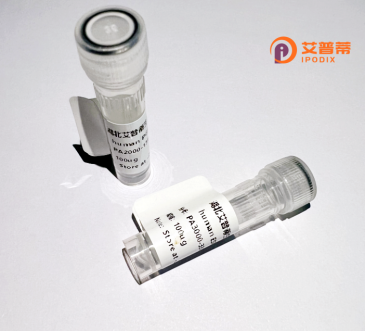
| 纯度 | >90%SDS-PAGE. |
| 种属 | Human |
| 靶点 | SH3BGR |
| Uniprot No | P55822 |
| 内毒素 | < 0.01EU/μg |
| 表达宿主 | E.coli |
| 表达区间 | 1-239 aa |
| 活性数据 | MPLLLLGETE PLKLERDCRS PVDPWAAASP DLALACLCHC QDLSSGAFPD RGVLGGVLFP TVEMVIKVFV ATSSGSIAIR KKQQEVVGFL EANKIDFKEL DIAGDEDNRR WMRENVPGEK KPQNGIPLPP QIFNEEQYCG DFDSFFSAKE ENIIYSFLGL APPPDSKGSE KAEEGGETEA QKEGSEDVGN LPEAQEKNEE EGETATEETE EIAMEGAEGE AEEEEETAEG EEPGEDEDS |
| 分子量 | 26.0 kDa |
| 蛋白标签 | His tag N-Terminus |
| 缓冲液 | PBS, pH7.4, containing 0.01% SKL, 1mM DTT, 5% Trehalose and Proclin300. |
| 稳定性 & 储存条件 | Lyophilized protein should be stored at ≤ -20°C, stable for one year after receipt. Reconstituted protein solution can be stored at 2-8°C for 2-7 days. Aliquots of reconstituted samples are stable at ≤ -20°C for 3 months. |
| 复溶 | Always centrifuge tubes before opening.Do not mix by vortex or pipetting. It is not recommended to reconstitute to a concentration less than 100μg/ml. Dissolve the lyophilized protein in distilled water. Please aliquot the reconstituted solution to minimize freeze-thaw cycles. |
以下是关于重组人SH3BGR蛋白的3篇代表性文献的简要信息:
1. **"SH3BGRL3 interacts with DYNLL1 to promote breast cancer malignancy via EGFR signaling"**
- **作者**: Wang Y, et al.
- **摘要**: 本文发现SH3BGR蛋白家族成员SH3BGRL3通过与DYNLL1蛋白相互作用,增强EGFR信号通路活性,从而促进乳腺癌细胞增殖和迁移。重组SH3BGRL3蛋白被用于体外功能验证实验。
2. **"Structural and functional characterization of the SH3 domain-binding glutamic acid-rich protein (SH3BGR) family"**
- **作者**: Chen X, et al.
- **摘要**: 本研究解析了人源SH3BGR蛋白的晶体结构,揭示其C端谷氨酸富集区的保守性。重组蛋白实验表明SH3BGR通过SH3结构域介导与多种信号蛋白(如c-Src)的相互作用,提示其在细胞黏附调控中的作用。
3. **"SH3BGRL2 overexpression correlates with poor prognosis in colorectal cancer"**
- **作者**: Li M, et al.
- **摘要**: 通过临床样本分析,发现SH3BGR家族成员L2在结直肠癌中高表达,与淋巴结转移和生存率下降相关。重组SH3BGRL2蛋白的过表达实验显示其通过激活Wnt/β-catenin通路促进肿瘤侵袭。
*注:SH3BGR家族研究相对较少,以上文献为功能相关研究示例,实际应用中建议通过PubMed等数据库以最新关键词检索具体研究方向。部分研究可能聚焦于SH3BGRL(心脏特异性亚型)或家族其他成员。*
**Background of Recombinant Human SH3BGR Protein**
The recombinant human SH3 domain-binding glutamic acid-rich protein (SH3BGR) is a member of the SH3BGR family, characterized by a conserved SH3-binding domain and a glutamate-rich C-terminal region. SH3BGR proteins are implicated in protein-protein interactions, particularly via SH3 domains, which are critical for signaling pathways regulating cell adhesion, motility, and differentiation. While the exact physiological role of SH3BGR remains under investigation, studies suggest its involvement in cardiovascular development, tumorigenesis, and immune modulation.
SH3BGR is expressed in various tissues, with high levels observed in the heart, skeletal muscle, and certain cancers. Its dysregulation has been linked to diseases such as hepatocellular carcinoma, breast cancer, and atrial septal defects, highlighting its potential as a biomarker or therapeutic target. For instance, SH3BGR may suppress tumor metastasis by interacting with cytoskeletal proteins or modulate TGF-β signaling pathways.
Recombinant SH3BGR, typically produced in *E. coli* or mammalian expression systems, enables functional studies to decipher its molecular mechanisms. It serves as a tool for exploring structural properties, binding partners, and downstream effects in cellular models. Ongoing research aims to clarify its dual roles in both normal physiology and disease contexts, offering insights for novel diagnostic or therapeutic strategies. Further studies are needed to unravel its tissue-specific functions and regulatory networks.
×